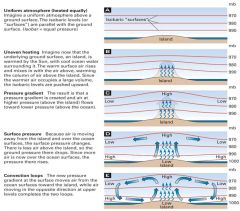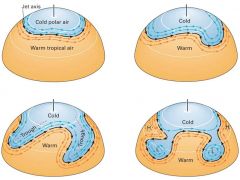![]()
![]()
![]()
Use LEFT and RIGHT arrow keys to navigate between flashcards;
Use UP and DOWN arrow keys to flip the card;
H to show hint;
A reads text to speech;
46 Cards in this Set
- Front
- Back
|
Define atmospheric pressure.
|
Pressure exerted by the atmosphere because of the force of gravity acting upon the overlying column of air.
|
|
|
What causes atmospheric pressure?
|
Atmospheric pressure is caused by the weight of a column of air above the Earth's surface forcing pressure on that area of the Earth's surface.
|
|
|
How does atmospheric pressure change with altitude?
|
Air pressure decreases with altitude because there is less air weighing down at higher altitudes.
|
|
|
Describe how pressure grandients drive wind.
|
Air tends to move from regions of high pressure to regions of low pressure, until the pressure at every level is uniform. Air moves along the pressure gradient to make everything equal
|
|
|
Discuss local wind systems.
|
Local wind systems are wind systems generated by local effects.
|
|
|
Explain convection loops.
|

Convection loops occur when an area above the Earth is heated more than another area. The air above the warmer area rises, creating lower pressure near the Earth and higher pressure at a higher altitude. The air at higher pressure at the higher altitude moves to areas of lower pressure. At this area the air descends over the cooler area and creates a higher pressure near the Earth. That air then moves towards the area of lower pressure above the warmer area, completeing the loop. (See graphic 1)
|
|
|
What is a pressure gradient?
|
A pressure gradient is a change of atmospheric pressure measured along a line at right angles to the isobars.
|
|
|
How do pressure gradients drive local wind patterns?
|
Air tends to move from regions of high pressure to regions of low pressure, until the pressure at every level is uniform. Air moves along the pressure gradient to make everything equal
|
|
|
How do convection loops develop?
|
Convection loops develop when there is unequal heating of a fluid.
|
|
|
What are two examples of local winds?
|
Valley breezes and sea land breezes
|
|
|
Explain the Coriolis effect.
|
Effect of the Earth's rotation that acts like a force to deflect a movin object on the Earth's suface to the right in the northern hemisphere and to the left in the southern hemisphere.
|
|
|
Discuss cyclones and anticyclones
|
Cyclones are areas of low atmospheric pressure where air spirals inward and upward. Anticyclones are centers of high atmospheric pressure where air spirals downward and outward. In the northern hemisphere, cyclones inspiral counterclockwise and anticyclones outspiral clockwise. The direction is opposite in the southern hemisphere.
|
|
|
What causes the Coriolis effect?
|
Effect of the Earth's rotation that acts like a force to deflect a movin object on the Earth's suface to the right in the northern hemisphere and to the left in the southern hemisphere.
|
|
|
How does the Coriolis force deflect the paths of moving objects?
|
The Coriolis force appears to deflect the paths of moving objects because it makes them deflect them to the right in the northern hemisphere and left in the southern hemisphere. This occurs regardless of the direction of motion.
|
|
|
How do cyclones and anticyclones develop?
|
|
|
|
Define Hadley cells and explain how they affect wind patterns
|
Hadley cell is a low latitude atmospheric circulation cell with rising air over the equatorial trough and sinking air over the subtropical high pressure belts (approx 30 degrees). As the air moves poleward, the Coriolis force turns it to the right.
|
|
|
Discuss the intertropical convergence zone (ITCZ) and the subtropical high-pressure belts
|
The ITCZ is a zone created when air from both hemispheres moves towards the equatorial trough. The ITCZ is where that air converges. There are two subtropical high pressure belts, each at about 30 degrees latitude. They are the area that air descends on the poleward side of the Hadley cell, so there surface pressures are high.
|
|
|
Describe monsoon circulation.
|
Monsoons are a result of subtropical high-pressure zones moving through the seasons
|
|
|
Explain the differences between pressure patterns in the northern and southern hemispheres.
|
The pressure patterns in the southern hemishpere are different because there is a massive anticyclone always present over Antartica. Surrounding the high is a band of deep low pressure, with strong, indward- spiraling westerly winds.
|
|
|
How do Hadley cells develop?
|
Hadley cells develop when the area above the equator is heated more than areas at higher latitudes. This creates a convection loop above the equator to about 30 degrees latitude.
|
|
|
Explain how pressure gradients develop at upper levels.
|
Pressure gradients develop at upper levels similar to how they do at the surface.
|
|
|
Explain how Rossby waves develop and grow.
|

|
|
|
Where do Rosssby waves develop?
|
Rossby waves develop in polar fronts- the zone where cold polar air meets warm tropical air.
|
|
|
Why are Rossby waves important?
|
Rossby waves are the reason weather in the midlatitudes is often so variable, because they cause pools of warm, moist air and cold, dry air to alternately invade midlatitude land masses.
|
|
|
Discuss geostophic wind.
|
Geostrophic wind is wind at high levels above the Earth's surface blowing parallel with a system of straight, parallel isobars. Upper air does not have friction force because it is so far from the source of friction- the surface. So there are only two forces on teh air parcel- the pressure gradient force and the Coriolis force. As the parcel of air accelerates, the Coriolis ofce pulls it increasingly toward the right. as its velocity increases, the parcel turns increasinly rightward until the Coriolis force just balances the gradient force. At that point, the sum of the forces on the parcel is zero, so its speed and direction remain constant.
|
|
|
Describe ocean currents and why they occur.
|
An ocean current is a persistent, dominantly horizontal flow of water. Ocean currents occur because the Earth is constantly trying to create an engergy balance. The currents are driven by differences in density and pressur acting along with the Coriolis force.
|
|
|
Explain the general features of global surface current patterns.
|
In surface currents, energy is transferred from the prevailing surace wind to water by the friction of the air blowing over the water surface. Because of the Coriolis effect, the actual direction of water drift is deflected about 45 degrees from the direction of the driving wind.
|
|
|
What is the basic metric unit of pressure?
|
The pascal (Pa)
|
|
|
How is wind direction identified?
|
The direction from which the wind comes- a west wind blows from west to east, for example.
|
|
|
Describe Valley breezes during the day.
|
During the day, mountain hill slopes are heated intensely by the sun, making the air expand and rise, creating a valley breeze. An air current moves up valleys from the palins below- opward over rising mountain slopes, toward the summits.
|
|
|
Describe Valley breezes during the night.
|
At night, the hill slopes are chilled by radiation, setting up a reversed convection loop. The cooler, denser hill slope air moves valleyward, down the hill slopes, to the plain below.
|
|
|
What effects the strength of the Coriolis effect?
|
The Coriolis "force" increases with the speed of motion but decreases with latitude.
|
|
|
What kind of weather are cyclones usually associated with? Why?
|
Cyclones are usually associated with cloudy or rainy weather. This is because when air is forced upware, it is cooled according to the adiabatic princple, allowing condensation and precipitation to begin.
|
|
|
What kind of weather are anticyclones usually associated with? Why?
|
Anticyclones are usually associated with fair weather. This is because when air sinks it is warmed by the adiabtic process, so condensation can't occur.
|
|
|
Isobars
|
Lines on a map drawn through all points having the same atmospheric pressure
|
|
|
Presure gradient
|
Change of atmospheric pressure measured along a line at right angles to the isobars
|
|
|
Convection loops
|
Circuit of moving fluid, such as air or water, created by unequal heating of the fluid.
|
|
|
Equitorial trough
|
The zone created by rising air at the equator that has a low surface pressure.
|
|
|
Convergence
|
The inward spiraling motion found in cyclones.
|
|
|
Divergence
|
The outward spiraling motion found in anticyclones.
|
|
|
trade winds
|
Winds around the subtropical high pressure center that spiral outward and moves toward the equatorial as well as middle latitudes. They are dependable trade winds that drove the siling ships of merchant traders.
|
|
|
Intertropical convergence zone (ITCZ)
|
The ITCZ is a zone of convergence of air masses along the equatorial trough.
|
|
|
Subtropical high-pressure belts
|
Subtropical high-pressure belts are belts of persistent high atmospheric pressure centered at about lat. 30 degrees N and S.
|
|
|
Jet streams
|
High-speed air flow in narrow bands within the upper-air westerlies and along certain other global latitude zones at high levels
|
|
|
Geostrophic wind
|
Wind at high levels above the Earth's surface blowing parallel with a system of straight, parallel isobars.
|
|
|
Polar front
|
The zone where cold polar air meets warm tropical air.
|

